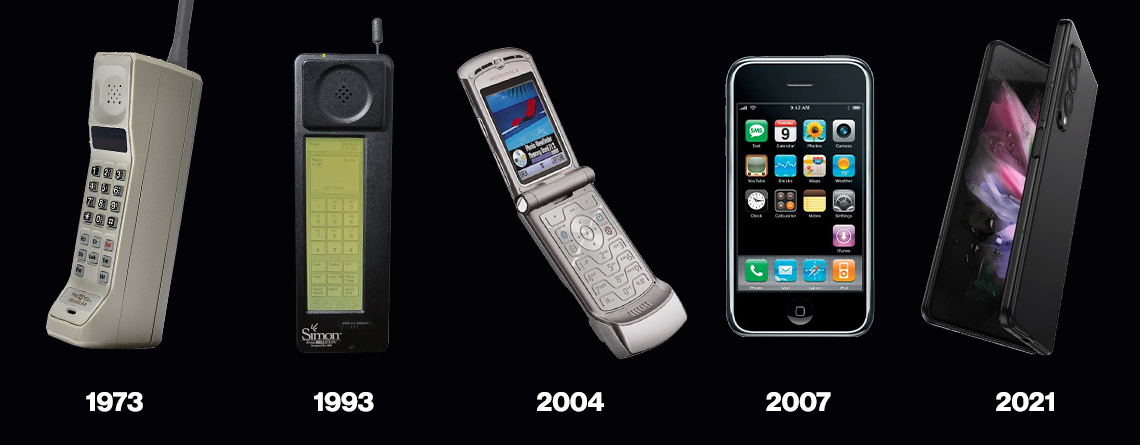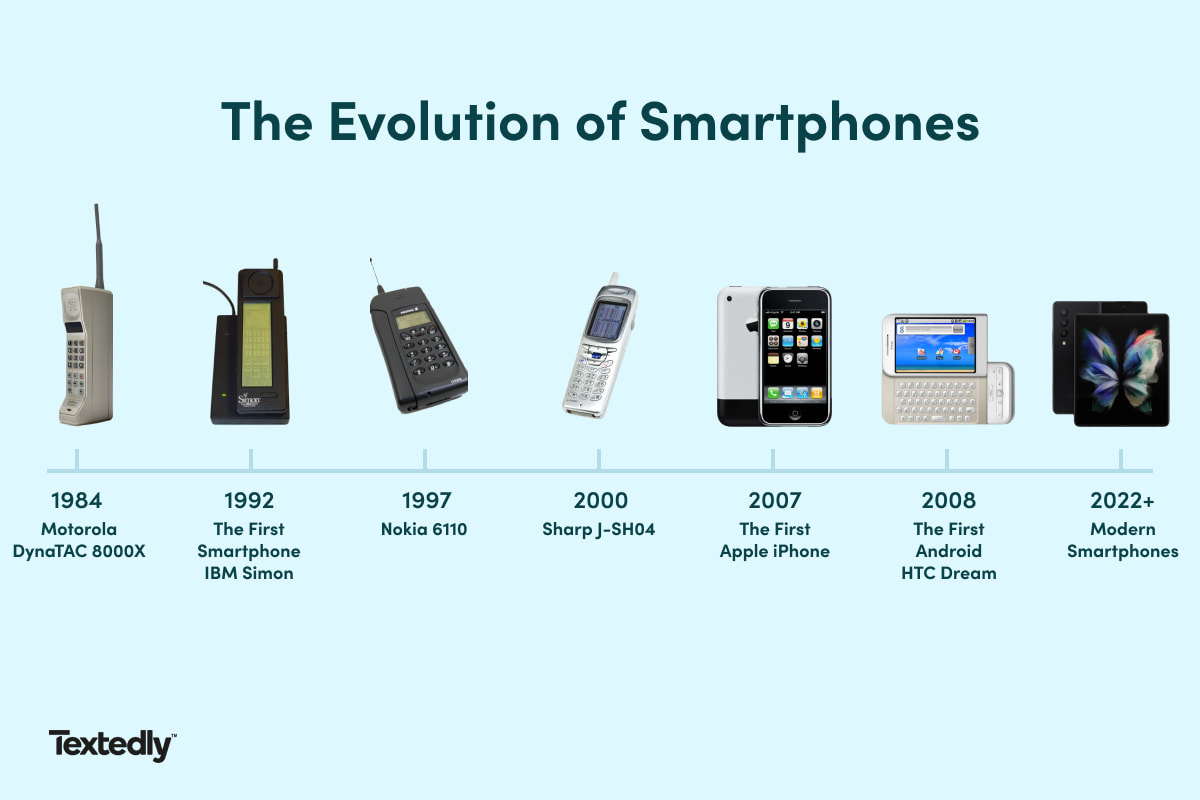The Fascinating History of Smartphones: From the Early Days to Modern Marvels
The history of smartphones is a captivating journey through technological evolution, revolutionizing how we communicate, work, and live our daily lives. These indispensable devices have gone from bulky, basic communication tools to sleek, high-performance powerhouses with extensive functionalities. This article will explore the fascinating development of smartphones, examining key milestones, influential inventions, and how smartphones have become an integral part of our world.
-min.jpg?width=1200&height=800&name=TXT-688-blog%201-1%20(1)-min.jpg)
The Birth of Mobile Phones
Before we dive into the history of smartphones, it’s crucial to understand the roots of mobile phones themselves. The journey began with mobile communication technology in the 1970s.
The First Mobile Phone: Motorola DynaTAC (1983)
In 1983, Motorola revolutionized the communications industry with the Motorola DynaTAC, the first commercially available mobile phone. Weighing around 2.5 pounds and standing 10 inches tall, it had a talk time of just 30 minutes and took about 10 hours to charge. While it lacked the features we associate with smartphones today, it paved the way for mobile communication, creating a foundation for what was to come.
The Evolution of Mobile Phones: From Analog to Digital
As mobile phones became more compact, they transitioned from analog to digital technology in the 1990s. This shift allowed phones to become more efficient, with better call quality and improved battery life. The first Nokia mobile phones with digital networks were a significant step forward in shaping the future of mobile communication.
The Emergence of Smartphones: 1990s – Early 2000s
The PDA Revolution: The Pre-Smartphone Era
Before smartphones as we know them today, Personal Digital Assistants (PDAs) ruled the tech world. Devices like the Palm Pilot and Psion Series were ahead of their time, allowing users to store contacts, calendars, and notes. These devices also had basic wireless communication features, marking a move toward a more mobile digital experience.
However, PDAs lacked cellular capabilities, which was a significant limitation. The smartphone revolution was on the horizon, but it would take a major technological breakthrough to merge communication and digital functions.
The First Smartphone: IBM Simon (1994)
The IBM Simon Personal Communicator, released in 1994, is often credited as the first true smartphone. While it lacked the sleek design of today’s devices, the Simon boasted features that would lay the groundwork for future smartphones. It combined mobile communication with a touch screen, allowing users to send emails, manage appointments, and even play simple games. This device proved that a phone could be more than just a way to make calls.

The Rise of Modern Smartphones: 2000s – 2010s
Apple iPhone: A Game-Changer in 2007
The most significant turning point in the history of smartphones came in 2007, when Apple introduced the iPhone. Steve Jobs’ vision of a multitouch interface that was simple and intuitive set the iPhone apart from its predecessors. By combining an iPod, phone, and internet communicator into one sleek device, Apple revolutionized the way we think about mobile technology.
The iPhone‘s success sparked a global smartphone race, with companies like Samsung, HTC, and Nokia scrambling to create their own smartphones.
Android vs. iOS: The Battle for Dominance
Following the launch of the iPhone, Google entered the smartphone arena with Android, an operating system designed to rival iOS. Android smartphones offered greater customization, open-source software, and a wider variety of devices, appealing to users seeking alternatives to Apple’s premium offerings.
The competition between iOS and Android has dominated the smartphone industry ever since, with both platforms evolving rapidly, integrating new technologies such as biometrics, mobile payments, and artificial intelligence.
Touchscreens and App Stores
Smartphones underwent further transformations in the 2010s with the expansion of touchscreen technology and the rise of mobile applications. The launch of app stores on both iOS and Android allowed developers to create apps that could extend the functionality of smartphones, from social media apps like Facebook and Instagram to mobile games, fitness apps, and financial tools.
The Emergence of 4G Networks
The rollout of 4G LTE networks in the early 2010s enabled smartphones to deliver faster internet speeds, unlocking the potential for video streaming, online gaming, and cloud services. This era marked a significant change in how smartphones were used, expanding their capabilities beyond communication to include a vast array of entertainment, work, and socialization functions.
The Modern Era of Smartphones: 2020s and Beyond
5G and the Future of Smartphones
The next big leap for smartphones is the introduction of 5G technology. With ultra-fast speeds and minimal latency, 5G will empower smartphones to handle even more demanding tasks, such as augmented reality (AR), virtual reality (VR), and real-time gaming. This technology promises to further solidify smartphones as the central hub for modern life.
Smartphones in the 2020s are also foldable, with devices like the Samsung Galaxy Z Fold offering cutting-edge designs that provide a tablet experience in the palm of your hand.

Artificial Intelligence and Smart Assistants
AI integration has become a hallmark of modern smartphones. Virtual assistants like Siri, Google Assistant, and Amazon Alexa now help users with everything from setting reminders to controlling smart home devices. AI is also being used in camera technology, personalized recommendations, and security features like facial recognition.
Foldable Phones and Cutting-Edge Design
As smartphone technology continues to evolve, manufacturers are experimenting with innovative designs. Foldable phones such as the Samsung Galaxy Z Flip and Huawei Mate X combine the portability of a phone with the functionality of a tablet. This trend represents the future of smartphones, as companies strive to push the boundaries of what these devices can do.
FAQs About the History of Smartphones
When was the first smartphone invented?
The first smartphone, the IBM Simon, was released in 1994. It combined a mobile phone with PDA features like email, contacts, and calendar, setting the stage for the smartphones we use today.
What was the first touchscreen phone?
While many devices used touchscreens, the Apple iPhone, released in 2007, is often credited as the first successful touchscreen smartphone, changing how we interact with mobile devices forever.
What is the difference between a smartphone and a regular mobile phone?
A smartphone combines traditional phone features with advanced functionalities like internet access, apps, GPS, and cameras. In contrast, regular mobile phones primarily focus on basic features like calling and texting.
How have smartphones evolved over the years?
Smartphones have evolved from simple communication tools to multifunctional devices with powerful processors, high-resolution cameras, and the ability to perform tasks like gaming, social networking, and mobile banking. The rise of touchscreens, mobile apps, and 5G technology has significantly expanded their capabilities.
What is the future of smartphones?
The future of smartphones is likely to include foldable designs, 5G capabilities, AI integration, and augmented reality features. As smartphones become even more powerful and versatile, they will continue to play a central role in our digital lives.
Conclusion
The history of smartphones is a tale of constant innovation and transformation. From the Motorola DynaTAC to today’s 5G smartphones, these devices have reshaped the way we communicate, work, and entertain ourselves. As technology continues to evolve, the future of smartphones promises to be even more exciting, with new capabilities that could further revolutionize our world. Whether it’s through AI, AR, or foldable screens, one thing is clear: smartphones are here to stay, and their role in our lives will only continue to grow.


